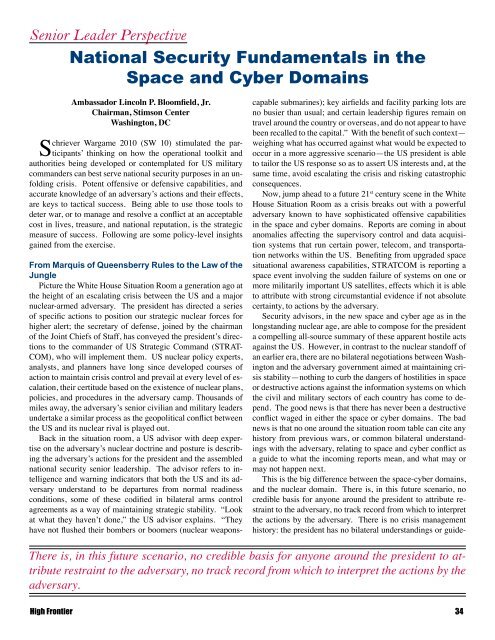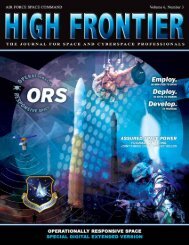Schriever Wargame 2010 - Air Force Space Command
Schriever Wargame 2010 - Air Force Space Command
Schriever Wargame 2010 - Air Force Space Command
- No tags were found...
Create successful ePaper yourself
Turn your PDF publications into a flip-book with our unique Google optimized e-Paper software.
Senior Leader Perspective<br />
National Security Fundamentals in the<br />
<strong>Space</strong> and Cyber Domains<br />
Ambassador Lincoln P. Bloomfield, Jr.<br />
Chairman, Stimson Center<br />
Washington, DC<br />
<strong>Schriever</strong> <strong>Wargame</strong> <strong>2010</strong> (SW 10) stimulated the participants’<br />
thinking on how the operational toolkit and<br />
authorities being developed or contemplated for US military<br />
commanders can best serve national security purposes in an unfolding<br />
crisis. Potent offensive or defensive capabilities, and<br />
accurate knowledge of an adversary’s actions and their effects,<br />
are keys to tactical success. Being able to use those tools to<br />
deter war, or to manage and resolve a conflict at an acceptable<br />
cost in lives, treasure, and national reputation, is the strategic<br />
measure of success. Following are some policy-level insights<br />
gained from the exercise.<br />
From Marquis of Queensberry Rules to the Law of the<br />
Jungle<br />
Picture the White House Situation Room a generation ago at<br />
the height of an escalating crisis between the US and a major<br />
nuclear-armed adversary. The president has directed a series<br />
of specific actions to position our strategic nuclear forces for<br />
higher alert; the secretary of defense, joined by the chairman<br />
of the Joint Chiefs of Staff, has conveyed the president’s directions<br />
to the commander of US Strategic <strong>Command</strong> (STRAT-<br />
COM), who will implement them. US nuclear policy experts,<br />
analysts, and planners have long since developed courses of<br />
action to maintain crisis control and prevail at every level of escalation,<br />
their certitude based on the existence of nuclear plans,<br />
policies, and procedures in the adversary camp. Thousands of<br />
miles away, the adversary’s senior civilian and military leaders<br />
undertake a similar process as the geopolitical conflict between<br />
the US and its nuclear rival is played out.<br />
Back in the situation room, a US advisor with deep expertise<br />
on the adversary’s nuclear doctrine and posture is describing<br />
the adversary’s actions for the president and the assembled<br />
national security senior leadership. The advisor refers to intelligence<br />
and warning indicators that both the US and its adversary<br />
understand to be departures from normal readiness<br />
conditions, some of these codified in bilateral arms control<br />
agreements as a way of maintaining strategic stability. “Look<br />
at what they haven’t done,” the US advisor explains. “They<br />
have not flushed their bombers or boomers (nuclear weapons-<br />
capable submarines); key airfields and facility parking lots are<br />
no busier than usual; and certain leadership figures remain on<br />
travel around the country or overseas, and do not appear to have<br />
been recalled to the capital.” With the benefit of such context—<br />
weighing what has occurred against what would be expected to<br />
occur in a more aggressive scenario—the US president is able<br />
to tailor the US response so as to assert US interests and, at the<br />
same time, avoid escalating the crisis and risking catastrophic<br />
consequences.<br />
Now, jump ahead to a future 21 st century scene in the White<br />
House Situation Room as a crisis breaks out with a powerful<br />
adversary known to have sophisticated offensive capabilities<br />
in the space and cyber domains. Reports are coming in about<br />
anomalies affecting the supervisory control and data acquisition<br />
systems that run certain power, telecom, and transportation<br />
networks within the US. Benefiting from upgraded space<br />
situational awareness capabilities, STRATCOM is reporting a<br />
space event involving the sudden failure of systems on one or<br />
more militarily important US satellites, effects which it is able<br />
to attribute with strong circumstantial evidence if not absolute<br />
certainty, to actions by the adversary.<br />
Security advisors, in the new space and cyber age as in the<br />
longstanding nuclear age, are able to compose for the president<br />
a compelling all-source summary of these apparent hostile acts<br />
against the US. However, in contrast to the nuclear standoff of<br />
an earlier era, there are no bilateral negotiations between Washington<br />
and the adversary government aimed at maintaining crisis<br />
stability—nothing to curb the dangers of hostilities in space<br />
or destructive actions against the information systems on which<br />
the civil and military sectors of each country has come to depend.<br />
The good news is that there has never been a destructive<br />
conflict waged in either the space or cyber domains. The bad<br />
news is that no one around the situation room table can cite any<br />
history from previous wars, or common bilateral understandings<br />
with the adversary, relating to space and cyber conflict as<br />
a guide to what the incoming reports mean, and what may or<br />
may not happen next.<br />
This is the big difference between the space-cyber domains,<br />
and the nuclear domain. There is, in this future scenario, no<br />
credible basis for anyone around the president to attribute restraint<br />
to the adversary, no track record from which to interpret<br />
the actions by the adversary. There is no crisis management<br />
history: the president has no bilateral understandings or guide-<br />
There is, in this future scenario, no credible basis for anyone around the president to attribute<br />
restraint to the adversary, no track record from which to interpret the actions by the<br />
adversary.<br />
High Frontier 34











